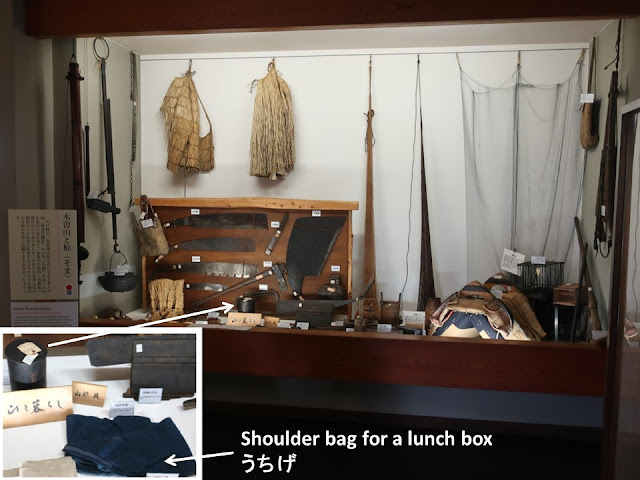The museum is near Yabuhara post-town
in Nagano prefecture of central Japan. It was on Nakasendou highway
which linked Edo (old name of Tokyo) and Kyoto. Mountains approach the town.
However, locals have developed specialties such as comb and medicine at the
narrow flatland. Plus, they have continued the exciting festival.
There were twelve post-towns in Kiso area, and each town had its feature.
My impressive exhibit is the letter; it
asked an official of each post-town to send over a sick traveler to his home
town. They are kind.
*Notice: there were no staff when I
visited. We have to push the buzzer by the entrance door, and to call staff
from another building.
中山道・鳥居峠の南側・藪原宿の近くにある郷土館です。山が迫った場所ですが、お六櫛や百草丸といった名産品を生み出し、活気がある祭りも催してきました。興業の意欲が強いと思います。木曽12宿といって、いろいろな宿場町がありますが、土地土地の特徴がありますね。
印象的だったのは、病気で歩けなくなった旅人を居住地(埼玉県)まで戻したいので、各宿場は駕籠で次の宿場に送ってくださいという送り状(の控え?)です。世は情けですね。
The museum is on the left. The train (lower left) transported woodcutters to mountains. Forestry is a major industry here.
郷土館は左側の建物です。右側に森林作業者の輸送用車両が展示されています。山に囲まれ、林業が主力産業ですね。
There is a park named “Starting station of water” in front of the museum. The source of the Kiso River, which is the seventh longest one in Japan (229 km), is at the mountain.
郷土館の前は、源流が近く公園になっています。川では鮎などを釣れます(遊漁承認証が必要)。
Exhibition room、展示室
There is a model of a workshop of the combs near the entrance.
入口付近には、名産のお六櫛の仕事場があります。
There are 120 teeth in a 120mm comb. The distance is just 1mm. It’s a mastery skill!
ツゲを使い、四寸(12cm)に120本の歯を挽く名人芸です。
There are four kinds of Oroku combs. It is written, “(1)Suki-gushi for cleaning one’s hair, (2)Tokashi-gushi for combing one’s hair, (3)Kazari-gushi for use as a hair accessory, (4)Yui-gushi for arranging one’s hair into traditional style” (“gushi” means “comb”).
細かいですね。お六櫛は四種類あります。①梳き櫛(髪の汚れを取り除く)、②解かし櫛(髪を整える)、③飾り櫛(髪飾り)、④結櫛(髪を結う)。この櫛は、梳き櫛でしょうか。
The theme of this display is “Herbal Medicine and the Worship of Mt. Ontake”. “The nearby Mt. Ontake has long been revered as sacred, and its foothills have been known to be a treasure trove of medicinal plants.” “Hyakusougan is still widely relied upon by locals today.” There is a factory of the medicine near the museum.
こちらの展示ケースでは、御岳山麓の豊富な薬草を使った薬産業(左)と、御嶽信仰の御歌や祈りの道具(右下)が展示されています。胃腸薬の百草丸は、常備薬として親しまれ、近くに日野製薬の工場があります。
The items about local forestry are exhibited, which make me feel their life. A wooden water bottle, a shoulder and so on.
木曽山と杣(そま、林業労働者)の展示です。尾張藩が杣と送り込んで、木を切ったそうですが、やがては木曽の農民がその仕事をするようになりました。水筒(左下)やめんば(弁当箱)を入れて、たすきにして背負ったうちげなど、生活のにおいがする品々があります。
Fowling nets are hung. A decoy bird was kept in a cage and caught migratory birds in late autumn. I don’t like a wild bird because of many bones, however, it was probably a treat in this area. “Fowling net” is prohibited now, because it catches a protected bird, too.
吊されている網は、かすみ網猟に使ったものです。囮の鳥を籠に入れて、渡り鳥を待ちました。晩秋の猟です。山鳥は骨が多くて、食べにくいと思いますが、きっと、ご馳走だったのでしょう。保護すべき鳥類も捕獲してしまうかすみ網猟は、現在は禁止されています。
The annual festival of Yabuhara Shrine, which is held early June, is the biggest festival in the area.
7月初旬に行われる薮原神社の例大祭は地域最大のお祭りです。
There are two floats; each one has a lion on it. Two lions dance together. Young villagers, who usually live in a city, return and take part in the festival.
山車に乗った二頭の獅子が出会い、舞を舞って合流するそうです。村外に住む若者たちも村へ戻り、祭りを支えています。
Reference website including a movie、参考サイト(動画含む):http://potiko.fc2web.com/comment/chubu/yabuhara/yabuhara_3.html
Post-town、藪原宿
Passports and so on are displayed at Yabuhara post-town section.
宿場に関するコーナーには、通行手形などが展示されています。
Old documents are displayed in the showcases in center of the room. The photo above is a flyer of a puppet show (Joururi); it was held in the post-town in the early 19th century. The program is concerning the fight and the love in the late 12th century (Dan-no-ura Kabuto Gunki). It is performed not only as a puppet show but also a kabuki play even until now. The post-town was a venue of entertainment for locals.
中央のショーケースには、古文書が展示されています。本陣の見取り図などもありますが、こちらは、文化年間(1804-1818)の藪原宿での浄瑠璃のチラシです。演目の「壇浦兜軍記」は今でも歌舞伎や浄瑠璃で演じられます。たくさんの人が集まったのでしょうね。宿場は地元の人にとっても、楽しい場所です。
The document above is a contract of a maid of an inn in 1860. She promised to work for the inn for ten years. The introducer wrote that he took all responsibilities including elopement. Ten years, it was too long.
女中さんの年季奉公の請け状(1860年)で、まささんが藪原宿の扇屋で10年間働く契約です。駆け落ちや逃亡も含めて紹介者が責任を持ちますというものです。10年は長いですね。
In 1833, a farmer (thirty-two years old) made a pilgrimage to Ise Shrine. However, he got sick and couldn’t walk more at Yabuhara. His hometown was more than 200km away. The officers of Yabuhara post-town wrote the letter above to the all officers of post-towns between Yabuhara and his hometown. The Yabuhara officers asked, “We take him on a palanquin and send to your post-town. So, kindly send him to your next post-town until he goes back home. He doesn’t have money, therefore, please take care of an inn and a meal. We sincerely ask your help." Although I'm not sure it happened often or not back then, it is a heart-warming letter.
伊勢参りの帰りに病気で歩けなくなった旅人(武州の百姓、32歳)を、駕籠で送るので、次の宿場まで送り、武州まで届けてくれという、1833年の送り状です。説明文には、「宿では情けをもって送っていただきたい。但し、金を持っていないので、昼や暮れになったら宿と米について配慮していただきたくお願いする」と書かれています。暖かいですね。送り主は、庄屋と組頭、宛先は、「中山道藪原宿より武州忍佐間村まで、宿のお役人様へ」となっています。
A big fire occurred in Yabuhara in the Meiji period (1868-1912), so many old buildings disappeared.
藪原宿では明治期に大火があり、町は新しいです。
Official website: https://www.vill.kiso.nagano.jp/kosodate_kyoiku/meisho/vr-kisomura-muse.html
(in Japanese)
Visited in August, 2023
Previous post (museum and festival in the
same town): Narai
post-town and Kami-toiya museum、奈良井宿と上問屋史料館
Next post (next post-town of Yabuhara): Miyanokoshi post-town、宮ノ越宿(中山道)

















Comments
Post a Comment